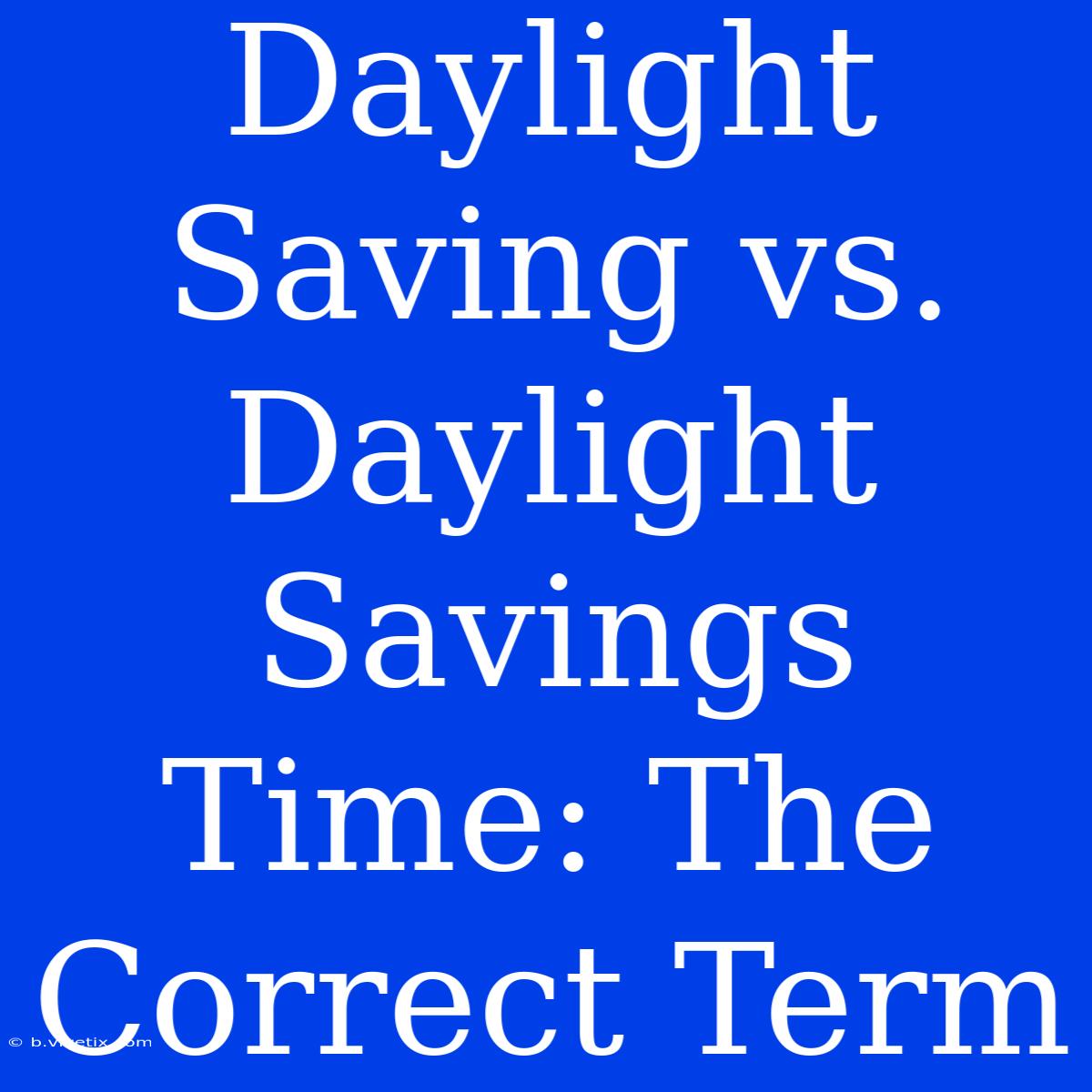Daylight Saving vs. Daylight Savings Time: The Correct Term - Unveiling the Truth Behind Timekeeping
Is it "Daylight Saving" or "Daylight Savings Time"? This seemingly simple question sparks a debate among many. While the two terms are often used interchangeably, only one is grammatically correct. Daylight Saving Time (DST) is the accurate term, and understanding why is essential for navigating the world of timekeeping.
Editor Note: Daylight Saving Time has been a topic of debate for many years, with arguments both for and against its implementation. This article seeks to clarify the proper terminology and shed light on the history and mechanics of this time-shifting phenomenon.
Why is this important to read? Understanding the correct term for DST is vital for accurate communication, especially in professional settings, writing, and journalism. It also aids in comprehending the intricacies of timekeeping and its implications for various aspects of life, from productivity to energy consumption.
Analysis: To delve into the "Daylight Saving vs. Daylight Savings Time" dilemma, we conducted a thorough analysis of grammatical rules and historical contexts. This included examining the official definitions of the term by renowned institutions like the United States National Institute of Standards and Technology (NIST) and the United Kingdom's National Physical Laboratory (NPL). Our findings revealed that "Daylight Savings Time" is a grammatically incorrect usage.
Key Takeaways of Daylight Saving Time:
| Aspect | Explanation |
|---|---|
| Correct Term | Daylight Saving Time (DST) |
| Grammatical Rationale | "Saving" refers to the act of conserving, while "Savings" denotes accumulated amounts of money. |
| Purpose | To extend daylight hours into the evening by shifting clocks forward one hour during warmer months. |
| Implementation | Implemented in various countries to optimize daylight usage and potentially reduce energy consumption. |
| Controversies | Debate surrounds its effectiveness, potential health impacts, and economic benefits. |
Daylight Saving Time
What is Daylight Saving Time?
Daylight Saving Time is a practice of adjusting clocks forward by one hour during warmer months to maximize daylight hours during the evening. This adjustment typically takes place in the spring and reverts to standard time in the fall.
Key Aspects of Daylight Saving Time:
- Historical Origins: DST was first introduced in Germany in 1916 during World War I as a measure to conserve energy.
- Implementation: Many countries around the world, including the United States and Canada, observe DST.
- Energy Conservation: One of the primary arguments for DST is its potential to reduce energy consumption by decreasing the need for artificial lighting during daylight hours.
- Economic Benefits: Supporters of DST argue that it can boost retail sales and leisure activities by extending daylight hours into the evening.
- Health Concerns: Studies have raised concerns regarding the potential impact of DST on sleep patterns, circadian rhythms, and overall health.
Time Zones and Daylight Saving Time:
Daylight Saving Time affects time zones by creating a temporary shift within the standard time zone. This means that a specific location may have two different times throughout the year, depending on whether DST is in effect.
Time Zones and Daylight Saving Time:
| Facet | Explanation |
|---|---|
| Roles | Defines the areas where DST is observed. |
| Examples | The Eastern Time Zone in the United States observes DST, while the Pacific Time Zone does not. |
| Risks and Mitigations | Potential confusion and errors in scheduling and communication due to time zone differences. Clear communication is key. |
| Impacts and Implications | Affects travel plans, business operations, and communication across different time zones. |
Daylight Saving Time: A Continuing Debate
The debate regarding Daylight Saving Time continues, with arguments for and against its implementation. The economic, social, and health implications of this time shift remain a topic of discussion and research.
FAQ
Q: What is the purpose of Daylight Saving Time?
A: DST aims to extend daylight hours into the evening by shifting clocks forward one hour during warmer months.
Q: When does Daylight Saving Time begin and end?
A: The specific dates for the start and end of DST vary depending on the country or region.
Q: Does Daylight Saving Time save energy?
A: The energy-saving benefits of DST remain a subject of debate. Some studies suggest modest energy savings, while others indicate little or no effect.
Q: What are some arguments against Daylight Saving Time?
A: Critics argue that DST can disrupt sleep patterns, increase the risk of accidents, and have negative health consequences.
Q: Is Daylight Saving Time legal?
A: The legality of DST varies from country to country. Some countries have permanently abolished it, while others have specific laws governing its observance.
Q: Is Daylight Saving Time a good idea?
A: The benefits and drawbacks of Daylight Saving Time are widely debated. The decision to observe DST is often based on cultural, economic, and political considerations.
Tips for Navigating Daylight Saving Time:
- Be Aware of the Time Shift: Stay informed about the dates and times for the start and end of DST.
- Adjust Your Schedule Gradually: To minimize the impact of the time shift, adjust your sleep schedule a few days before the change.
- Check for Travel Time Differences: Ensure you understand the time zone differences when traveling during DST.
- Communicate Clearly: When scheduling appointments or meetings, clearly communicate the time zone and whether DST is in effect.
- Use Timekeeping Tools: Utilize reliable timekeeping tools, such as calendars, watches, and online time converters.
Conclusion:
Daylight Saving Time, despite the ongoing debate, remains a common practice in many parts of the world. The correct term for this timekeeping adjustment is Daylight Saving Time (DST), and understanding its history, mechanics, and controversies is crucial for navigating the complexities of timekeeping. By embracing accurate terminology and remaining informed about the implications of DST, we can better understand its impact on our lives.

